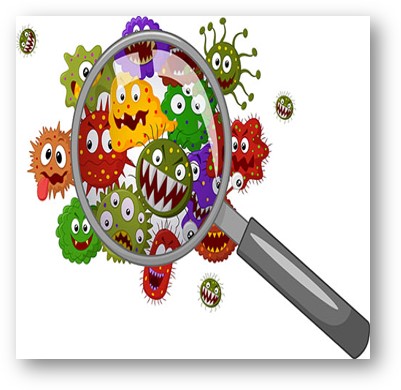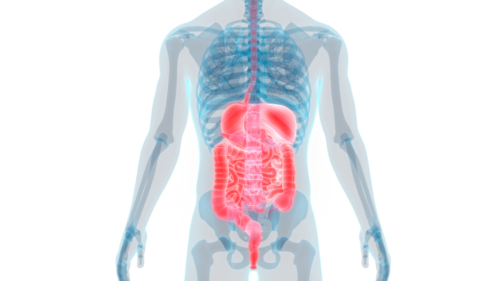In my first article on gut health I explained how I discovered the microbiome. In this second article, I will be talking about our gut and our microbes.
Our gut
Our gut is a 9-metre long tube stretching from mouth to anus. A recent piece of scientific research in Sweden stated that if we were to take our gut out and spread it flat, it’s surface area would be the size of a badminton court. In other research I have read, scientists have estimated it to be the size of a tennis court! Whichever it is, we know that it is certainly very large.
Our gut passes from our mouth on into our oesophagus and then our stomach. Our stomach empties into our small intestine which is made up of the duodenum, jejunum, and ileum. The large intestine follows which has four parts: the cecum, colon, rectum, and anus.
Mainly water is absorbed in our large intestine so the majority of absorption of vitamins, minerals, fats, proteins and carbohydrates takes place in the small intestine helped by finger-like villi which capture and absorb the nutrients from our food. These villi also serve the purpose of increasing the surface area of our gut. However, the lining of the gut here is very thin, just a single layer of cells line the villi and these enterocytes are essentially what protects our insides from the world outside. Embedded in the lining of our gastrointestinal tract lie three important organ systems: our immune system, our nervous system and our endocrine system and in fact:
- 70-80% of our immune cells are in our gut, which makes sense as this in the interface between potential toxins from the outside world passing through into our bodies.
- The nervous system in our gut is called the enteric nervous system and a vast number of neurons are contained here, similar to the number of neurons in the spinal cord and far more than in any other peripheral organ. The nervous system is our bodies communication system and many of our neurotransmitters, chemicals that transmits messages around our body via our neurons, are made in our gut.
- The gastrointestinal tract is the largest endocrine organ in the body producing a large number of our hormones, collectively called the enteric endocrine system.
Our microbes
 But it isn’t just our cells that are responsible for the absorption of nutrients and the production of our neurotransmitters and hormones, our cells also work closely with the vast number of microbes that completely fill our intestines. In fact, the whole of our small and large intestine is rammed full of microbes, there is no space. Some are floating free, but some contact the cells which line our gut. The lining of our gut is covered by a layer of mucus which is also full of microbes which is our first line of defence when it comes to stopping anything bad from getting into our bloodstream. Immune surveillance is essential at this gut/blood interface, every molecule has to be assessed and quarantined. The good microbes here cleanse and maintain the integrity of the gut wall as well as working collectively to digest and absorb our foods and to protect us from lurking pathogens.
But it isn’t just our cells that are responsible for the absorption of nutrients and the production of our neurotransmitters and hormones, our cells also work closely with the vast number of microbes that completely fill our intestines. In fact, the whole of our small and large intestine is rammed full of microbes, there is no space. Some are floating free, but some contact the cells which line our gut. The lining of our gut is covered by a layer of mucus which is also full of microbes which is our first line of defence when it comes to stopping anything bad from getting into our bloodstream. Immune surveillance is essential at this gut/blood interface, every molecule has to be assessed and quarantined. The good microbes here cleanse and maintain the integrity of the gut wall as well as working collectively to digest and absorb our foods and to protect us from lurking pathogens.
Our microbes are highly organised, there are some good and some bad, the latter can cause inflammation making us ill, whilst the good ones fight to keep us well. It’s like a war zone down there, beneficial versus opportunistic! Our microbes are divided into 3 main groups:
- Essential or beneficial microbes, these are our good guys.
- Opportunistic microbes (the bad guys) of which there are around 500 known species at present and in a healthy person these are tightly controlled and limited by our beneficial microbes.
- Transitional microbes which are just passing through and in a healthy person they do this, but in an unhealthy person they can hang around causing disease.
If the opportunistic microbes are winning the war then we suffer from something called dysbiosis: an imbalance of good versus bad microbes, ie. not enough good and too many bad. When we damage our microbiome, because it is closely linked to our immune system, this innate system kicks in and an inflammatory response occurs. We all know what inflammation feels like, for example, if you cut your finger it may go red, get hot and even swell up. This is what happens within our gut when we suffer from dysbiosis. An inflammatory response releases inflammatory proteins, chemicals which can then pass across the thin gut lining into the blood stream where they are then at liberty to travel throughout the body causing havoc with other bodily systems, including our brain.
The ileum, which is the last three-fifths of the small intestine is packed with lymph nodes which have a very important immune function. These lymph nodes filter bad microbes and toxins and imprison them and also release lymphocytes to fight toxins. A healthy person has a gut lumen packed with lymphocytes fighting off toxins. Importantly, lymphocytes produce immunoglobulins and an important one is called IgA which protects the gut wall and fights off pathogenic microbes. People who have a dysbiotic gut generally have low levels IgA and therefore little defence. When levels of IgA and other immune regulators drop in the gut, then the immune response in the whole body gets out of balance.
So, it is our gut cells together with our microbes that affects what ends up in our blood, how our hormones are produced, how our nervous system (including our brain) functions and how our immune system responds. If we damage it then the effects are wide reaching and not just restricted to the gut but to the rest of the body. Hence, dysbiosis can show up:
- In your digestive system as IBS (Irritable Bowel Syndrome) or more seriously and an IBD (Inflammatory Bowel Disease) such as Crohn’s or Ulcerative Colitis.
- On your skin as eczema, psoriasis, rosacea or acne.
- In your joints as stiffness and aching.
- In your nervous system as mood swings and fatigue.
- In your brain as anxiety and depression.
You have probably heard of the saying “You are what you eat”. Well there is some truth in that statement but more importantly, you are what you absorb, which is determined by your gut cells together with your gut bugs and there is more to come on this in the next article.
If you want to find out more about the microbiome, gut health and how you can heal yourself and your clients from the inside out, please contact Andrea at andrea@andreabremner.co.uk or visit her website www.andreabremner.co.uk

